Pup
Side On
June 8 – 19 1999
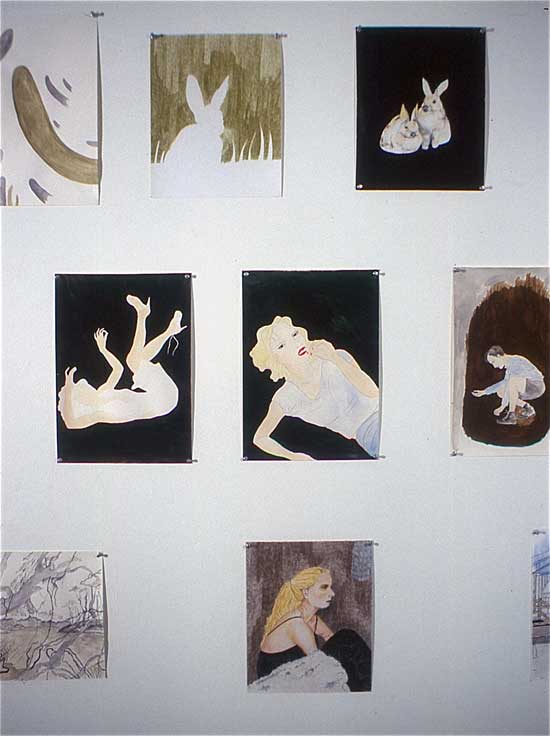 |
| Philipa Veitch, Pup, installation view (detail), gouache, coloured pencil, graphite, pen, ink on paper, 1999 |
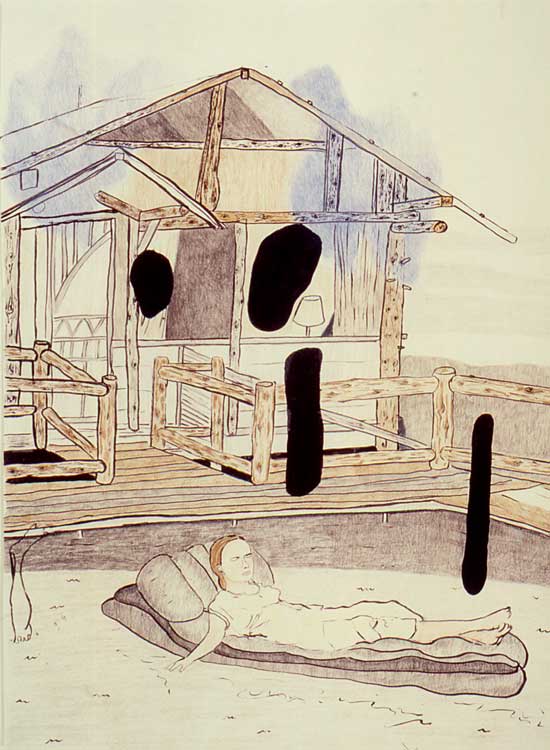 |
| Philipa Veitch, One and a half hour patient, pen, coloured pencil, graphite on paper, 350mm x 280mm, 1999 |
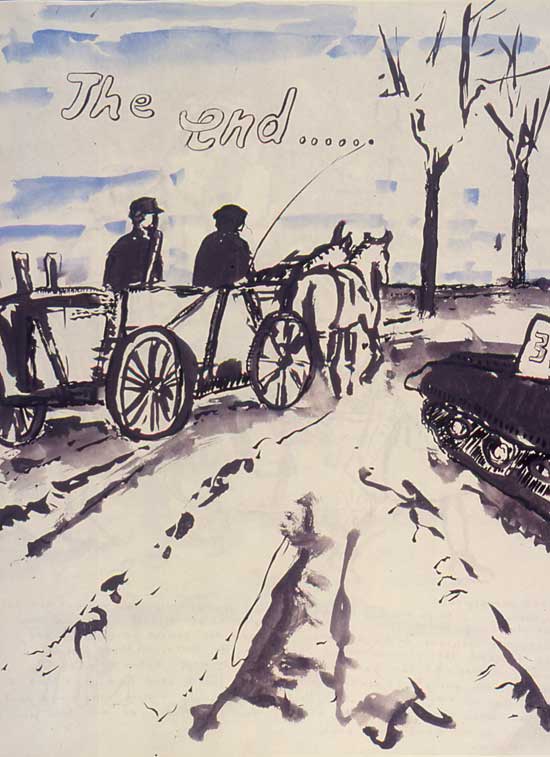 |
| Philipa Veitch, The End (1), pen, gouache on paper, 590mm x 420mm, 1998 |
 |
| Philipa Veitch, Hypothesis of the Imagination, pen, coloured pencil on paper, 350mm x 280mm, 1998 |
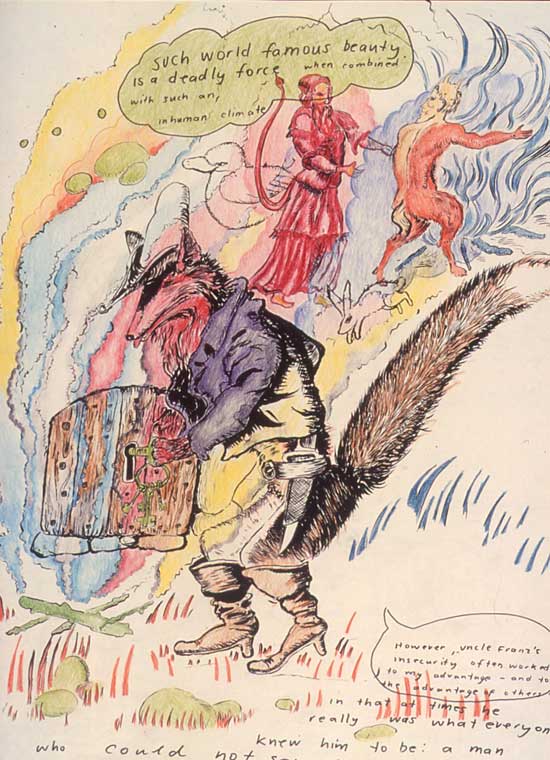 |
| Philipa Veitch, Such World Famous Beauty is a Deadly Force, pen, coloured pencil on paper, 350mm x 280mm, 1998 |
 |
| Philipa Veitch, Furry Boy, pen, coloured pencil on paper, 350mm x 280mm, 1998 |
 |
| Philipa Veitch, Pup, installation view (detail), gouache, coloured pencil, graphite, pen, ink on paper, 1999 |
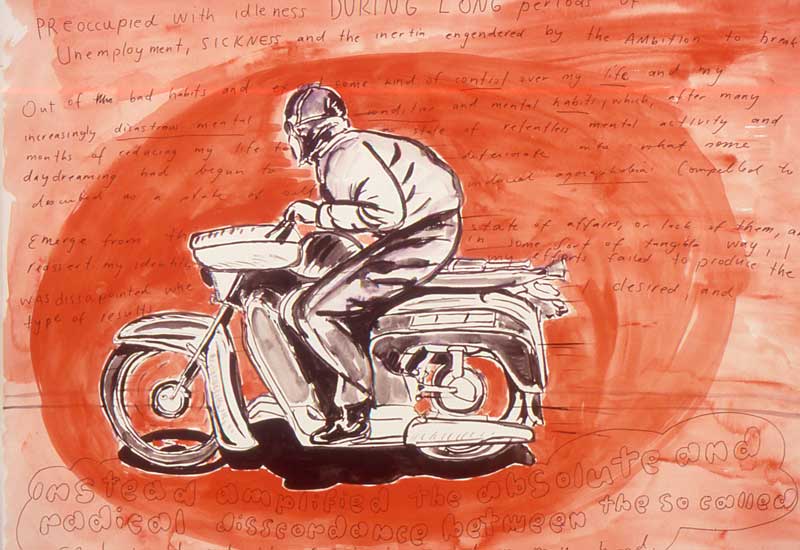 |
| Philipa Veitch, Motorcycle Emptiness, gouache, pen on paper, 420mm x 590mm, 1998 |
Veitch’s hybrid adventures
As an art student at high school I recall studying Antoinne Watteau’s ‘Embarkation for the Isle of Cythera’. It is a singularly peculiar work divided into two component parts. The first of these represents the ‘Age of Reason’s,’ hyper-civilians about to embark for the mythological isle of love. The second indicates the way to that hallowed island via a spiral of cherubs diminishing toward the horizon. The passage from one state to another is equally a journey towards death although in this instance those departing, bathed in an ethereal autumnal glow, are lucky enough to be departing for seemingly heavenly extinguishment through which the various difficulties of civilized existence will finally be done away with. The work hinges ultimately however on the tension between utopian promise and the somewhat melancholic acknowledgement of the impossibility of establishing absolutes. Veitch’s ensemble of drawings, ‘Pup’ function in a similar manner. Behind many of these lurk notions of utopian escape. In this instance however, the utopias the artist draws upon relate to the various perhaps prosaic worlds of fashion, childhood, high-speed travel and myths of exotic otherness. Soon departing herself for China, the artist draws upon hybrid imagery to conjure and recall personal pasts and futures.
Overall Veitch’s work subscribes to the pure currency of images. Many of her works are created through a process of grafting in which montage and citation function to create multivalent narratives. Like the filmmaker Sergei Eisenstein famed for his techniques of jump editing, Veitch realises that by placing apparently contradictory pictorial information side by side ambiguous possibilities arise. Sometimes the works that result function at a near hallucinatory level as a kind of associative hypertext notable for its sheer interpretability. In other instances the artist allows the iconic aspects of random signs to resonate in ways that rather than critically illuminate, subjugate the image to its pure sign value. In this way imagery lifted from say populist advertisements become the hallmarks of a world of mock spirituality through the sudden disappearance of mechanistic relativities. The final product of this process is a series of layered screens hinting at future possibilities whilst reminding us of indicators of common pasts.
Adding to these processes of free-floating accretion are texts, random words, sentences that force the present imagery into suggestive alternatives. The non-linearity of these words and texts are partially biographical, seemingly cathartic indicators of an attempt to shed life’s problems. References to these shared difficulties allow us increased identification with the imagery. Thus an illustrative representation of a 60’s motorbike and rider signals our departure from the scene and from the theatre of representation itself. Representation becomes both the means of transportation into a possibly better world and the signpost of a world we wish to leave behind in our on-going process of self-refinement and awareness. Similarly the self’s metamorphosis is viewed as synonymous with languages ability to transform and to displace unidimensional readings of our contemporary place in time and space. The seriousness of such concerns however is underscored by a palpably wry humour that like the concerns it illustrates, seeks to de-site our absolute identification with the truth of what is pictured.
‘Pup’ is a word both calming and disturbing in its effect. It connotes the supposed cosiness of childhood and of pets. Alternatively it indicates the arrival of a new organism, one yet to learn the harsh realities of existence and identity. The ‘pup’ is new to concepts of identity. One the one hand this is an advantage for it allows identity to remain supple and open to a continued reinvestment of itself through the acquisition of knowledges. On the other hand the new organism is ever vulnerable to attacks on its ego. By forgoing shoring up its place in the world the ‘pup’ allows equally its contamination and corruption and possible extinguishment from outside. Remaining new however has its benefits for it has the ability to keep us enticed and to hold our interest. As the world of imaginary images swirls about us we take hold of those most closely representative of our own experiences. From these we derive meaning. Our capacity to laugh at those meanings encourages our further identification for we remain entertained. Our engagement with the work continues to be double edged however. The fox elegantly smoking the hookah, is an illustration familiar form childhood. The character knowingly imbibes its own representational otherness suggesting its alienability. The adventures we embark upon are known and unknown, both exhilarating and confounding in their promise.
Alex Gawronski, 1999

